Mastering the art of smoking a turkey requires attention to detail and a passion for the craft. Follow this smoked turkey cheat sheet to ensure that you are well-equipped to make a memorable turkey dinner.

Choosing the Right Turkey
Thanksgiving is quickly approaching, and it’s time to prepare for your feast! Truthfully, the best results start with selecting the right turkey. Choose between fresh or frozen or all-natural or pre-brined. As always, make sure you have enough space in your smoker to accommodate it.
Freshness Matters: Choose a fresh or properly thawed turkey. Fresh turkeys tend to have better flavor and texture. If you’ve purchased a frozen turkey, see below for best thawing methods.

- Size: Choose a turkey size that will fit inside your grill or smoker with lots of room left over. A 14-pound turkey is suitable for most gathering, but you might need to double up if feeding a large group.
- Fresh: Consider purchasing in an fresh, unfrozen, all-natural turkey, if you’re short on time and plan to use a brine.
- Frozen: If you’ve purchased a pre-packaged frozen turkey, make sure it doesn’t contain a brine solution or is self-basting.
Time Management
Plan ahead! A frozen turkey can take 2 to 5 days or more to thaw safely in the refrigerator. Purchase your turkey 2-4 weeks in advance. A frozen turkey will take 1 day per 4-5 pounds of meat to thaw. That means that a 14-pound turkey will take at least 3 full days to thaw completely. Add another 24 hours if you’re planning to brine it. Now you’re looking at 4 full days.
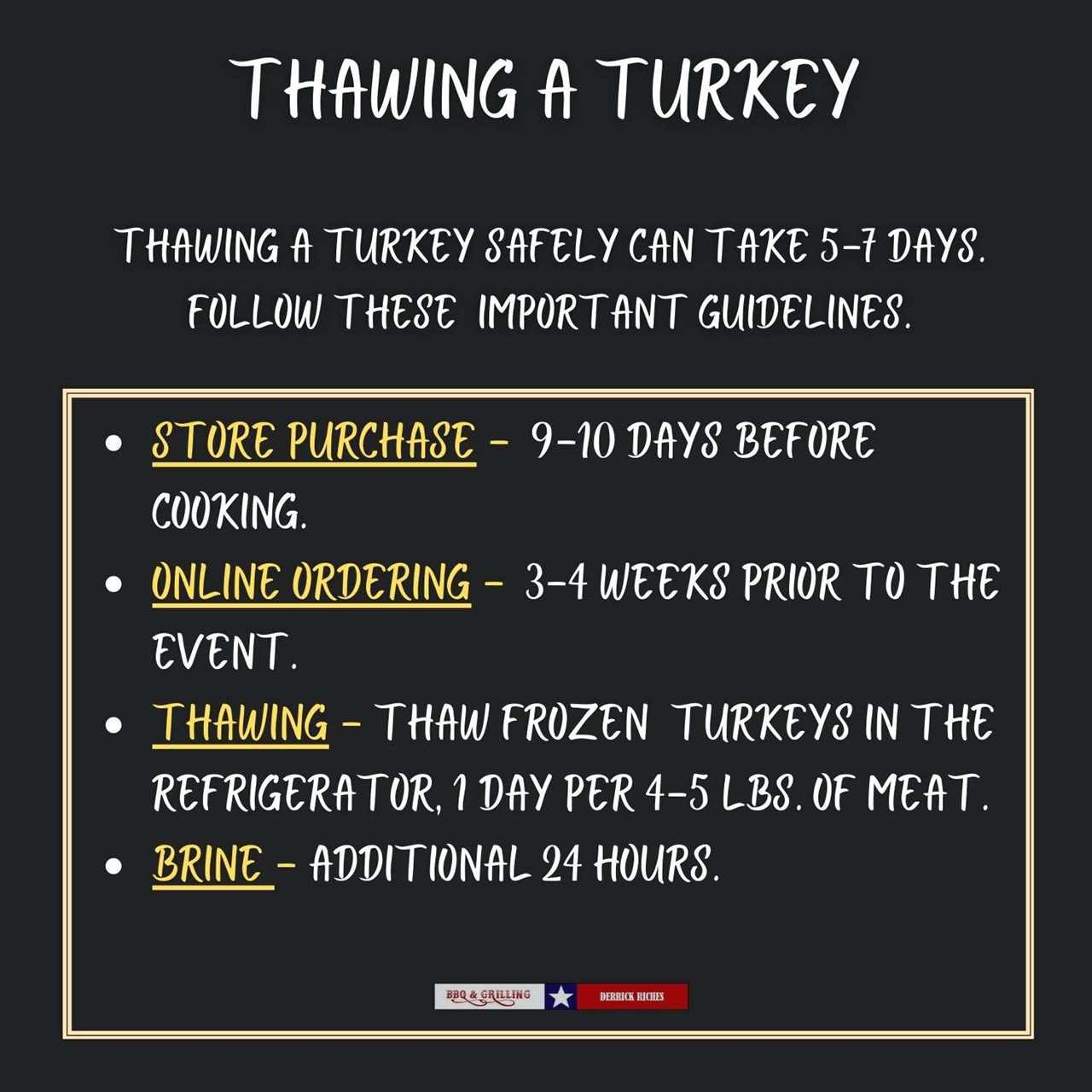
Best Woods for Smoking Turkey
When it comes to smoking turkey, choose your wood wisely. Keep in mind that poultry is a delicate meat and that more robust woods, like hickory or mesquite, might overpower it. The goal is to have a pleasant, almost sweet, or nutty smoky flavor. Use mild to moderate smoke-producing woods as follows:
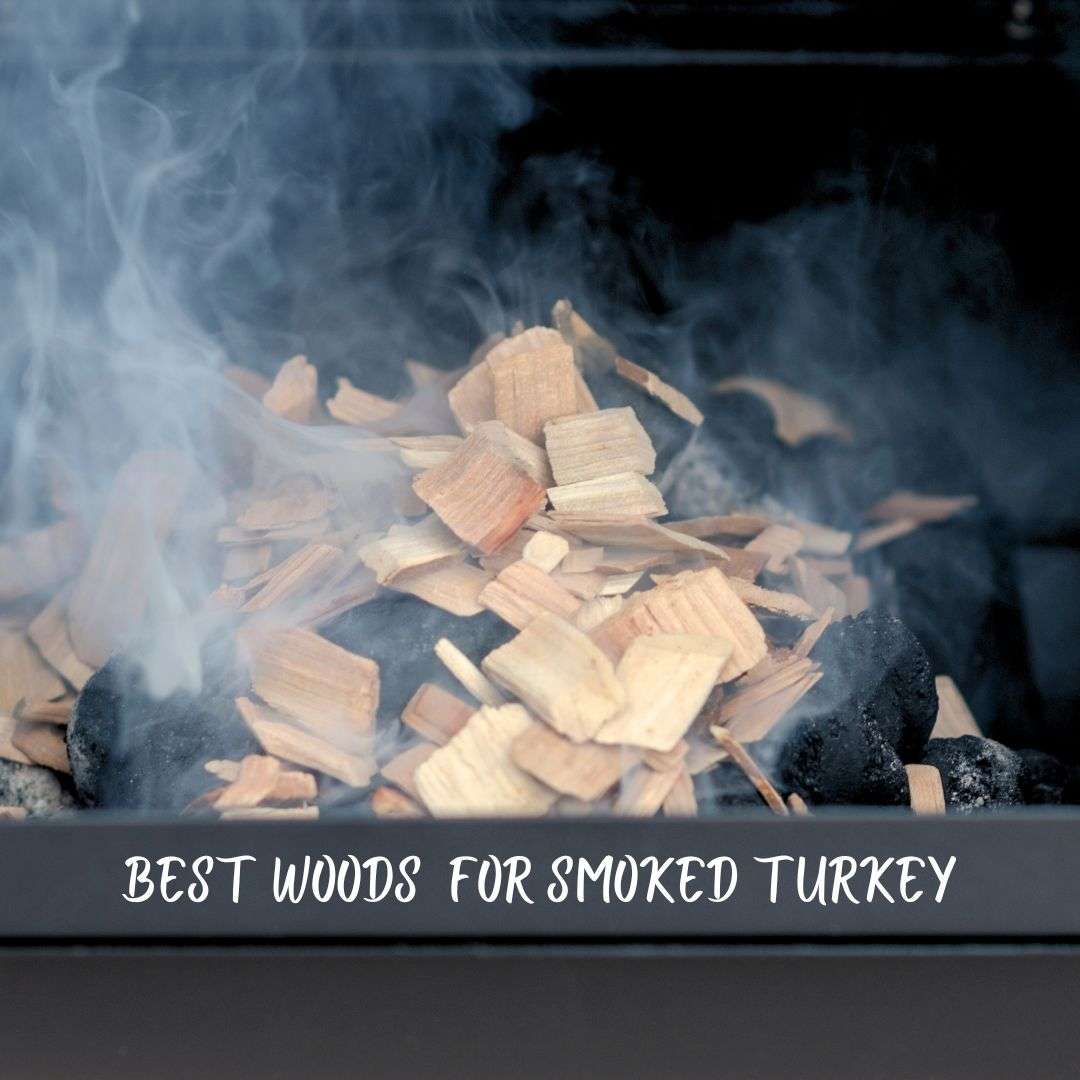
- Fruitwoods (Apple, Cherry): Impart a mild, sweet flavor that complements the turkey without overpowering it.
- Pecan: Adds a slightly sweet, nutty flavor, enhancing the overall taste of the smoked turkey.
- Maple: Imparts a delicate sweetness, adding a subtle layer of flavor to the smoked turkey.
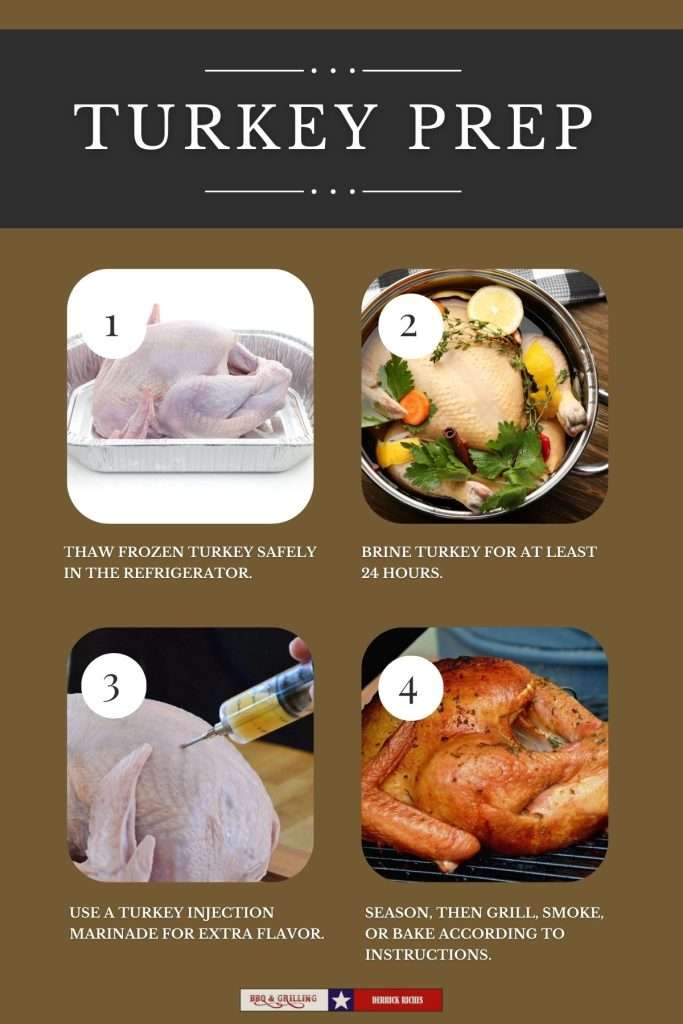
Preparation
Once your turkey is ready, elevate its flavor profile by using a brine, injection marinade, and a good seasoning blend.

- Brine it yourself: Brining is an important step for moist and flavorful meat. Brine solutions are typically made of water, salt, sugar, and aromatic spices. The turkey is submerged in the brine for 18-24 hours, allowing the flavors to penetrate the meat. Making the brine yourself will allow you to take control of the ingredients. You can also apply a dry brine.
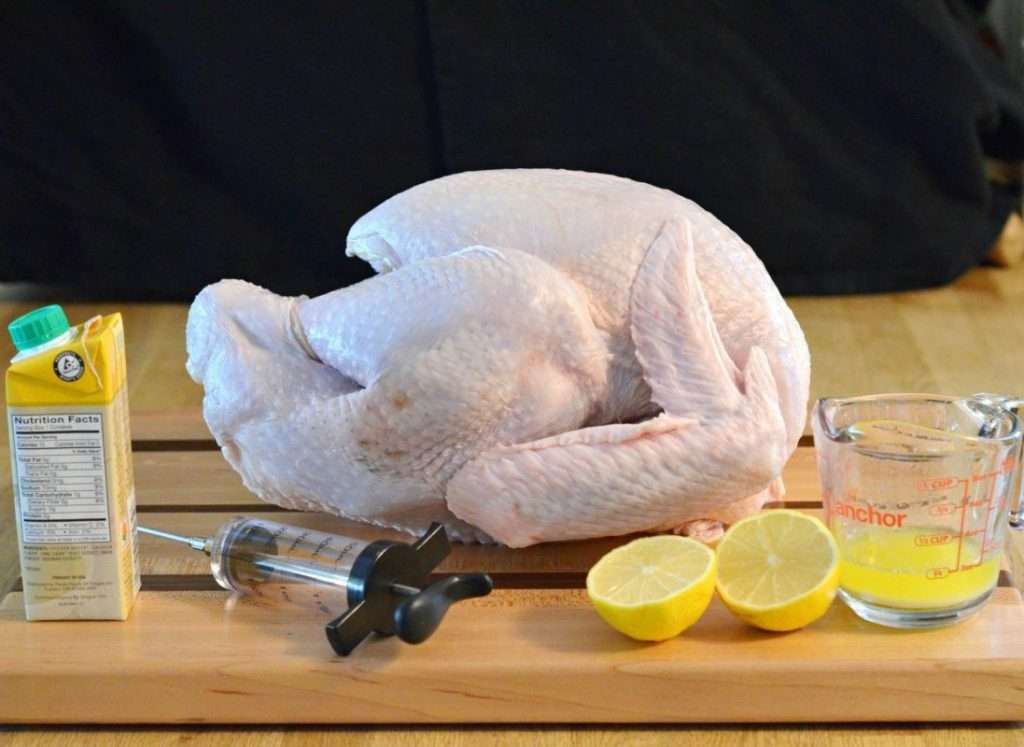
derrickriches.com
- Injection Marinade: These marinades are made of broth, melted butter, and spices, that are then injected into various parts of the turkey. An injection marinade adds flavor from the inside out, and helps keep the turkey meat moist during cooking.

- Rub: Create a dry rub using a blend of herbs, spices, and salt. Apply the rub evenly over the turkey’s surface, under the skin, and inside the cavity.
- DO NOT place stuffing inside your Thanksgiving turkey before it hits the smoker. Serve it separately. It will dry out and become too smoky to ingest. Instead, place a large peeled onion inside to cavity to help flavor the bird, and release steam and moisture as it cooks.
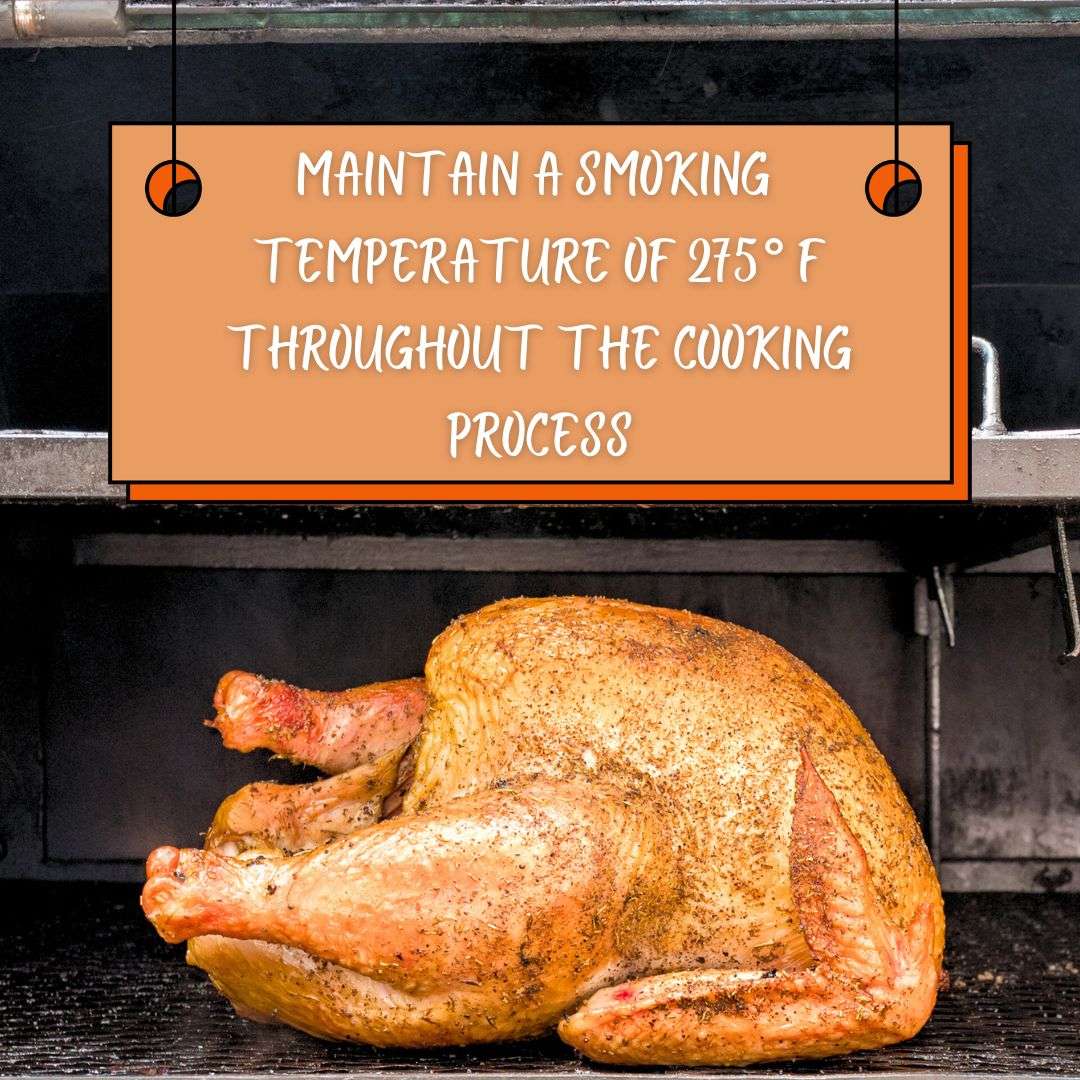
Smoking Temperature
Maintain a steady smoker temperature of 275 degrees F. Consistency is key to achieving a perfectly smoked turkey. Invest in a reliable meat thermometer or temperature probe to monitor the internal temp throughout the cooking process.
Cooking Time
Cooking times for whole turkeys can take anywhere from 6-8 hours depending on the size of the turkey (or turkeys), your equipment (pellet grill, Big Green Egg, offset smoker, aluminum foil, and a drip pan), and environmental factors like the weather, altitude, and more. Ensure that you have enough fuel (charcoal, wood pellets, wood chips etc.) to get through an 8-hour cook. Even if it takes less time, it’s always a good idea to be prepared. And remember, you can always finish roasting the turkey in your oven.
- Whole Turkey: Plan for approximately 30 minutes per pound for a whole turkey. This is a general guideline, so monitor the internal temperature for doneness.
- Spatchcock Turkey: Spatchcocking, or removing the backbone, reduces cooking time. Estimate around 20 minutes per pound for a spatchcock turkey. The same holds true for a bone-in turkey breast.
Should you baste a smoked turkey?
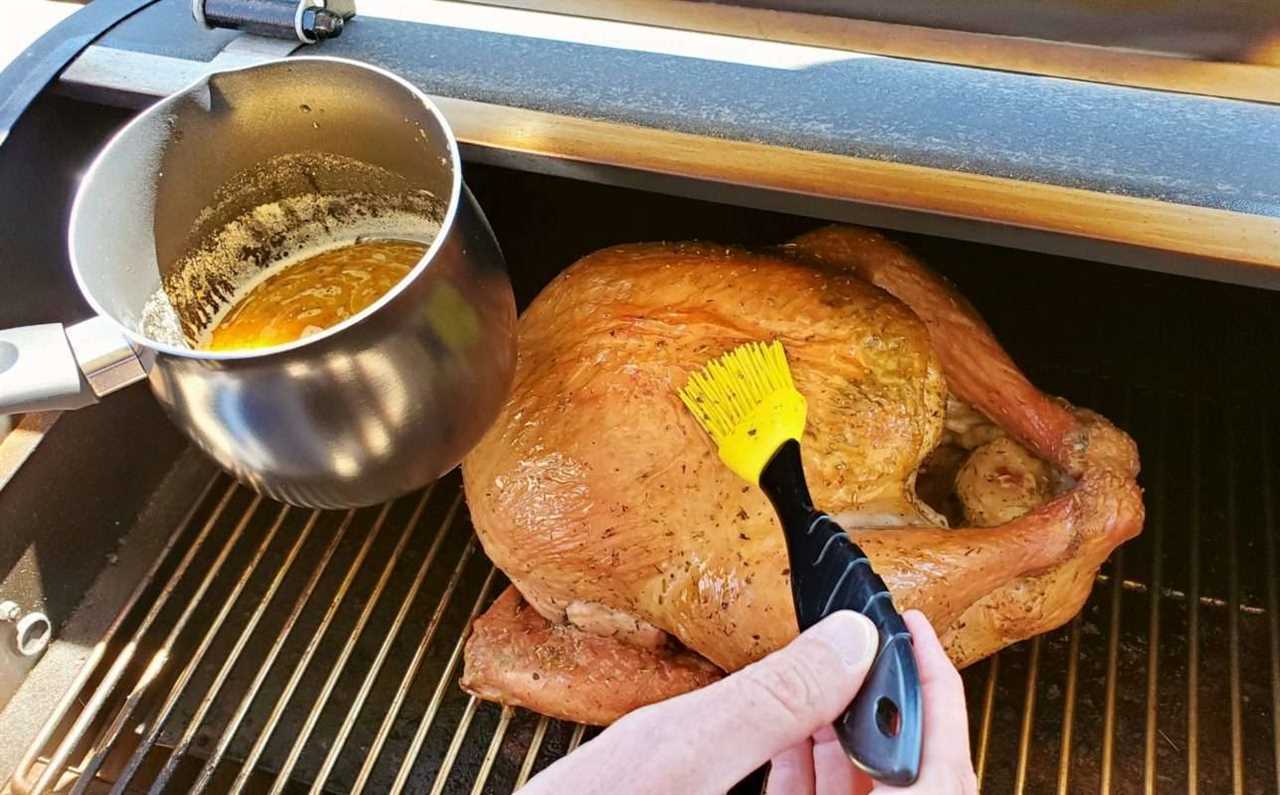
Basting a smoked turkey is important for two reasons: it enhances flavor and promotes moisture. Baste the turkey every 1-2 hours, during the second half of cooking, with a mixture of melted butter, herbs, and garlic.
Internal Temperature
Some experts swear by 160 degrees, while others say that 165-175 degrees F is the way to go. It’s best to err on the safe side. Dark meat can be quite temperamental and needs a little more time to cook. Be patient and keep safety your number one priority when cooking a turkey. No one wants to experience a food-borne illness from Thanksgiving dinner. See below for tips and techniques.

- Thermometer Placement: Insert the thermometer in the thickest part of the thigh and breast without touching the bone. This internal temperature provides a good estimate of the turkey’s overall doneness.
- Temperature Targets: Aim for an internal temperature of 165 degrees F in the breast and 175 degrees F for the thigh.
- Carryover Cooking: This occurs once the turkey is removed from the grill or smoker. The heat inside the turkey will temporarily rise and equalize (see resting below).
Resting the turkey
Place the cooked turkey on a clean cutting board after cooking and tent it with foil. Allow it rest for at least 20-30 minutes to allow the juices to redistribute. Besides, this will give you time to prepare the gravy!
Carving and Serving
Thanksgiving is all about the presentation. Some folks like to place their smoked turkey on a platter garnished. Others like to carve the bird first, then plate it. The choice is entirely yours, but first, did you know there is a right way to carve a turkey?

- Carving: Carve the turkey by removing the thigh and leg portion from one side, then separate this section into two pieces. Next, remove the wing and breast from the same half of the turkey. Slice the breast and thigh pieces. Repeat the process on the other side.
- Sides: Serve the smoked turkey with your favorite sides, such as sausage stuffing, mashed potatoes, and cranberry sauce.
Storing Leftover Turkey
Thanksgiving wouldn’t be complete without leftovers, and proper handling is important. Refrigerate any remaining turkey within two hours of cooking to prevent bacterial growth.
- Timely Refrigeration: Refrigerate leftover turkey within 2 hours of cooking to prevent the growth of harmful bacteria.
- Storage Options: Store leftover smoked turkey in a large airtight container in the fridge for 3-4 days, or freeze in vacuum-seal bags for up to 3 months.
- Thawing frozen leftovers: For best result, that frozen leftovers 12-24 hours in the refrigerator before rewarming. Discard any leftover turkey that appears slimy or has a foul odor.
The post Smoked Turkey Cheat Sheet appeared first on BBQ & Grilling with Derrick Riches.
 Backyard GrillingWeekend WarriorsAdvice from DadBeard GroomingTV Shows for Guys4x4 Off-Road CarsMens FashionSports NewsAncient Archeology World NewsPrivacy PolicyTerms And Conditions
Backyard GrillingWeekend WarriorsAdvice from DadBeard GroomingTV Shows for Guys4x4 Off-Road CarsMens FashionSports NewsAncient Archeology World NewsPrivacy PolicyTerms And Conditions
